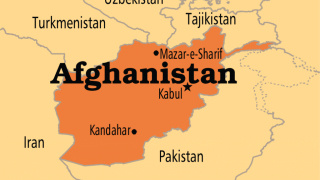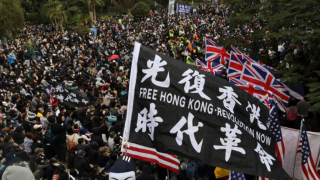Hybrid War In The Western Hemisphere
The 21st-century geopolitics of South America are inseparable from the ongoing New Cold War between the unipolar US and the multipolar forces of Russia, China, and Iran. In the strategic context of this book, however, the competition between the US and China will figure most prominently in analyzing the changing geopolitical situation in South America. Before getting to the specifics of what this all entails, however, it’s necessary to introduce a few broader concepts such as Hybrid War and the contradictory worldwide ambitions of the US and China.
The Hybrid War research conducted thus far for both the author’s earlier 2015 book “Hybrid Wars: The Indirect Adaptive Approach To Regime Change” and his follow-up article series for Oriental Review has explored the most pertinent and likely forecasted battlegrounds in the Eastern Hemisphere, yet this method of externally catalyzed political change is also applicable to the Western Hemisphere as well, and in particular, to South America.
The strategic situation in this part of the world is entirely different than in the other half, however, owing mostly to the fact that this is the US’ “backyard” and it’s accordingly much more sensitive to uncontrollable and rampant destabilization. It’s not that Washington necessarily fears that every Hybrid War in the Western Hemisphere will inevitably creep into the country across the southern border (though in the case of Mexico or anything that destabilizes it, this is a startling possibility), but that it would ideally prefer to control as many countries as it can with a minimum of damage to their existing infrastructure so that they can more easily be integrated into what the author refers to as “Fortress America”.
“Fortress America”
This grand strategic ambition is one of the highest foreign policy priorities of the US anywhere in the world. The idea is that the US wants to establish full-spectrum dominance over the entire Western Hemisphere so that it can function as the ultimate geostrategic redoubt in the event that the Hybrid Wars in the Eastern Hemisphere are wildly more successful than anticipated and lead to full-blown divide-and-rule chaos in Afro-Eurasia. From the perspective of US strategists, the two Americas are geographically insulated by the Atlantic and Pacific Oceans from most of the problems on the other side of the world, so it’s very possible that they could ‘ride out’ the indefinitely prolonged period of tri-continental chaos so long as the proper integrational mechanisms are in place beforehand. By this, it’s meant that the US wants to totally control and manage hemispheric affairs so as to extract maximum benefit from the human and physical resources in the rest of the Americas, which is why it’s detrimental to Washington’s long-term strategy to turn the supercontinent into a Mideast-like warzone.
It’s not to say that the US wouldn’t ever resort to such measures if its leading strategists and decision makers made a subjective and risky determination that this was the “least-bad option” for advancing their vision, but just that they will more than likely err on the side of caution and prefer instead to use “constitutional coups” and Color Revolutions as opposed to full-fledged Hybrid Wars such as the kind that have been deployed all throughout the Eastern Hemisphere. It’s relatively simpler to orchestrate ‘controlled’ regime change scenarios in Latin America than in Afro-Eurasia because of the fact that most of the societies in the US’ “backyard” have been so deeply split along the liberal-conservative/left-right domestic political fault line since their early 19th-century independence that this aspect has essentially become part of their national identities by this point. While a cynic could argue that the much richer identity diversity among the religions, ethnic groups, and histories of the people of the Eastern Hemisphere makes that part of the world a much more fertile ground for Hybrid Wars, a reasonable retort would be that the political divisions ingrained in the ‘national DNA’ of the Latin American states makes them a lot easier to quickly destabilize, as has been seen from many examples during the Cold War and across the last decade.
Containing The Regime Change Conflicts
It’s precisely because of Latin America’s comparative lack of identity diversity that Hybrid Wars here are theoretically easier to ‘contain’ and ‘control’ than elsewhere in the world since there’s less of a risk that they’ll take on a ‘life of their own’ by becoming ‘auto-synchronous’ Hobbesian conflicts between a multiplicity of identities. To broadly simplify, the main identity divisions within Latin America boil down to the liberal-conservative/ left-right rivalry; several ethno-racial differences between natives, whites, blacks, and mulattos; the discord between secularists/atheists and religious conservatives/evangelicals; and the emerging trend of militant environmentalists versus the developmental state. Even though Latin America has a very impressive multi-millennial history, just about all of the factors pertaining to that which could contribute to an exacerbated intensity of Hybrid Wars (such as that which have continually existed in the Eastern Hemisphere) have been wiped out following the European colonization of the supercontinent, which is why one can say that modern-day “history” in the strategically pertinent sense that’s being explored in this series didn’t “begin” until the early 19th-century independence of these fledgling states.
The author means no disrespect whatsoever to any of the native inhabitants of the Americas and the intent is not at all to downplay their historical contribution to their homelands and contemporary societies (especially in Bolivia, for example), but to draw attention to the fact that the “organic differences” between indigenous identities in the Western Hemisphere have been for the most part existentially overridden by European colonization and are thus not too pertinent to dwell upon when discussing the Hybrid War vulnerabilities of each regional state. There are no Mideast-like generational divisions between sects, ethnicities, and civilizations that can be exploited on a relevantly large enough scale in Latin America such as can occur in the tri-continental pivot space of Afro-Eurasia, for example, which is why it’s conceptually much easier to manage Hybrid Wars in this part of the world as opposed to elsewhere. Theories and expectations, however, don’t always pan out as they’re ‘supposed’ to, which is why the research will touch upon some of the deeper geopolitical nuances inherent to South America in order to get a clearer indication of the international dynamics of Hybrid War in the continent.
For the most part, ‘traditional’ Hybrid Wars such as the type seen most vividly on display in the Eastern Hemisphere only really have a practical chance of occurring in Venezuela and Bolivia, although one might even be able to include Ecuador into the mix depending on how the domestic situation there develops (and the degree of influence that the US decides to exert on socio-political events). In general, however, there are scant possibilities for Hybrid Wars in any of the South American countries to uncontrollably spill over their borders and seriously destabilize their neighbors, though the nearby Latin American region of Central America and the country of Mexico remain as the main exception to this seeing as how the international drug syndicates have already embedded their disruptive transnational presence into the national fabric of those states.
Hatching The Hybrid Wars
This brings the analysis along to discussing the ways in which the US hatches Hybrid Wars all throughout the hemisphere and in particular across South America. While the specific tactics do change on a case-by-case basis as modified for the local particularities of the asymmetrical battlefield, they generally have a few common denominators in one way or another. NGOs and other “civil society” activists obviously form the vanguard of all incipient Color Revolution movements, while the Unconventional Warfare aspect of Hybrid War usually depends on one or more of the following four factors:
US Corporate Interests:
The interests of US agricultural companies historically served as the primary impetus for sparking Washington’s intervention in a given country, though this has since evolved to represent neo-liberal US corporate interests in general regardless of any specific sector.
DEA:
The Drug Enforcement Agency functions as the tip of the spear for destabilizing countries from within and co-opting the most functional regime change elements within them to take part in fomenting coup attempts, which is precisely why states such as Venezuela and Bolivia kicked the DEA out.
School Of The Americas (SOA)/Western Hemisphere Institute for Security Cooperation (WHINSEC):
Known as the School of the Americas until its 2001 rebranding as the Western Hemisphere Institute for Security Cooperation, this Georgia-based facility is notorious for training many Latin American military and intelligence leaders who would later go on to stage pro-US coups in their country.
Organization of American States (OAS):
The final element of regime change pressure that the US typically stands to wield against targeted Latin American states is to multilaterally pressure them through the Washington-controlled OAS, which diplomatically functions as a psychological-diplomatic weapon against their leaders.
Splitting The Scope
The organizational division of the book is as follows. The present chapter will continue along with describing the South America’s geostrategic significance to the rest of the world, while the forthcoming one will present an overview of South American history. Chapter three will then explore the role that each country endeavors to play in the landmass’ larger geopolitical framework and prognosticate on the most likely patterned developments to take place across the next decade. Finally, the last chapter will then talk about the “Battle of the Blocs” that the US is seeking to provoke as a means of advancing “Fortress America”.












